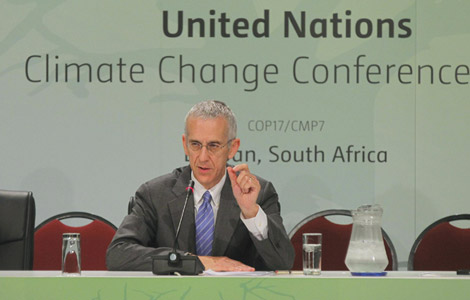White paper on rural poverty reduction
Updated: 2011-11-16 10:50
(Xinhua)
|
|||||||||||
BEIJING - The Chinese government on Wednesday unveiled a white paper on its poverty reduction efforts in the past decade, highlighting achievements and challenges for China to bring common prosperity to its more than 1.3 billion people.
The white paper, titled New Progress in Development-oriented Poverty Reduction Program for Rural China, was released by the State Council Information Office.
It introduces China's policies, achievements, special programs, social involvement and international cooperation in the fight against poverty.
It was the Chinese government's second white paper on poverty reduction after it issued the first edition of such document in 2001.
POOR POPULATION FALLS
The white paper says the mission to reduce poverty is particularly difficult in China given the scale of poverty in rural areas.
According to the white paper, China's poverty-stricken rural population fell from 94.22 million at the end of 2000 to 26.88 million at the end of 2010, an equivalent to lifting the entire population of France out of poverty in the past decade.
The proportion of poor people in the country's rural population decreased from 10.2 percent in 2000 to 2.8 percent in 2010.
The Chinese government defines those who earn less than 1,274 yuan (about $200) in income a year as "poor people" after the nation raised the national poverty line for rural residents from 865 yuan in 2000 to 1,274 yuan in 2010.
China has basically solved the problem of providing adequate subsistence, food and clothing for its rural residents, the 36-page white paper declares.
By the end of 2010, the illiteracy rate of young and middle-aged people had dropped to 7 percent, 5.4 percentage points lower than in 2002, according to the white paper.
"The Chinese government has always made poverty reduction an important goal and task of national development...and worked hard to enable all the people to enjoy the fruits of economic and social development," the white paper says.
It was in the mid-1980s that the Chinese government started the development-oriented poverty reduction program in the rural areas in an organized and planned way.
The program has promoted social harmony and stability, fairness and justice, and contributed to the development and progress of the country's human rights.
As poverty reduction is a common cause for the entire human society, China's development-oriented poverty reduction program is an important component of the world's poverty reduction efforts, says the white paper.
The white paper stresses China has realized, ahead of schedule, the goal of cutting the poverty-stricken population by half, as listed in the United Nations Millennium Development Goals, thus making great contributions to the world's poverty reduction efforts.
CHALLENGE REMAINS
Although China's overall national strength has been greatly improved, the Chinese government is clearly aware that China remains a developing country with low per-capita income and is faced with the serious challenge of narrowing the gaps between urban and rural areas, between different regions, and between the rich and poor, says the white paper.
The current 26.88 million impoverished Chinese people are equal to the entire population of Texas, the second-largest state of the United States by population size.
The white paper says that the deep-rooted obstacles hindering the development of China's poverty-stricken areas are still there, such as the large size of the impoverished population, comparative deprivation, frequent cases of sinking back into poverty, and underdevelopment of regions with special difficulties that lie in vast and contiguous stretches.
"Therefore, development-oriented poverty reduction is and will continue to be an arduous and long-term task for the Chinese government," it says.
The white paper says China will continue to shoulder its international duties suitable to its development phase and development level and actively participate in international poverty reduction as a responsible country.
China is keen to continue working with the international community to create a beautiful and poverty-free world where people enjoy common prosperity, says the white paper.
According to the white paper, support from foreign funds has been an important part of China's development-oriented poverty reduction drive.
The country received a total of $1.4 billion in 110 foreign-funded poverty alleviation projects, benefiting nearly 20 million impoverished people in 20 provinces, autonomous regions and municipalities, says the white paper.
Related Stories
Translating growth into poverty reduction 2011-08-15 16:10
Regional poverty-relief pilot scheme launched 2011-11-16 01:04
Moving beyond the mountain of dire poverty 2011-11-07 07:52
Man plants trees to rise from ashes of poverty 2011-10-22 11:15
Hot Topics
HIV/AIDS, Egypt protest, Thanksgiving, climate change, global economic recovery, home prices, high-speed railways, school bus safety, Libya situation, Weekly photos
Editor's Picks

|

|

|

|

|

|







